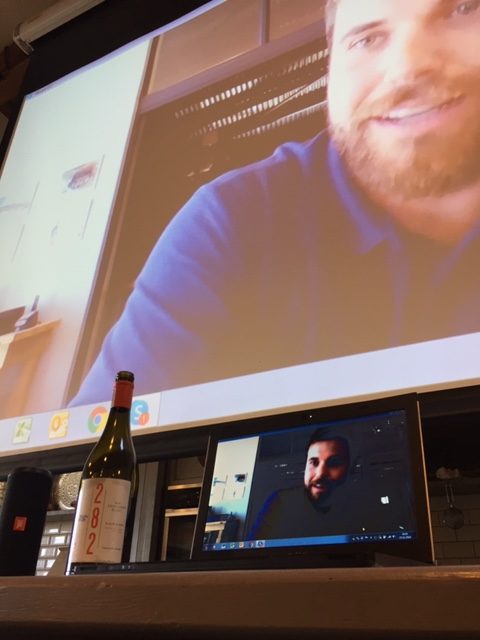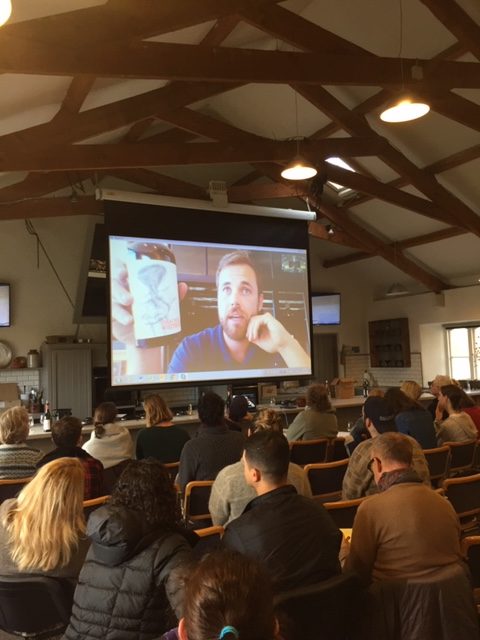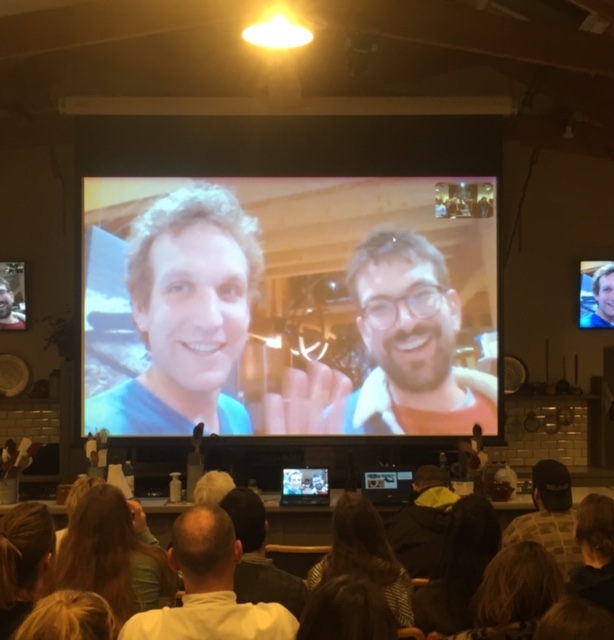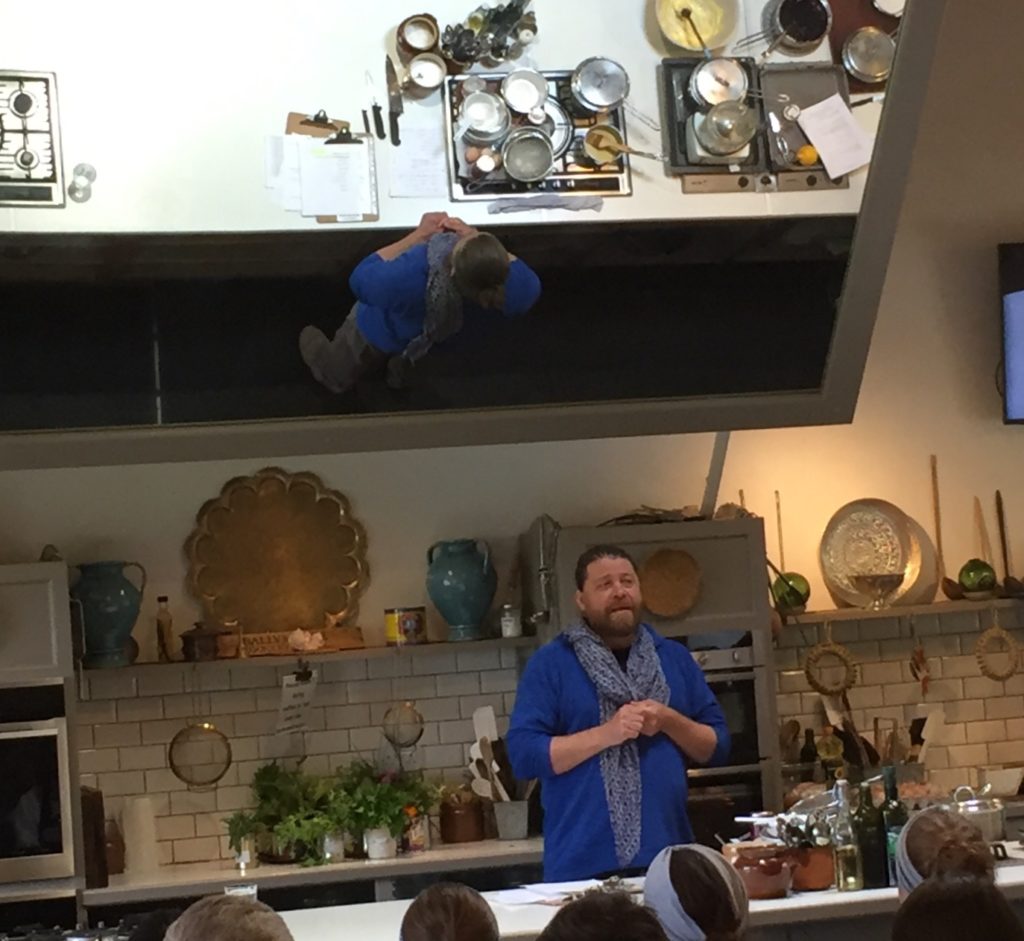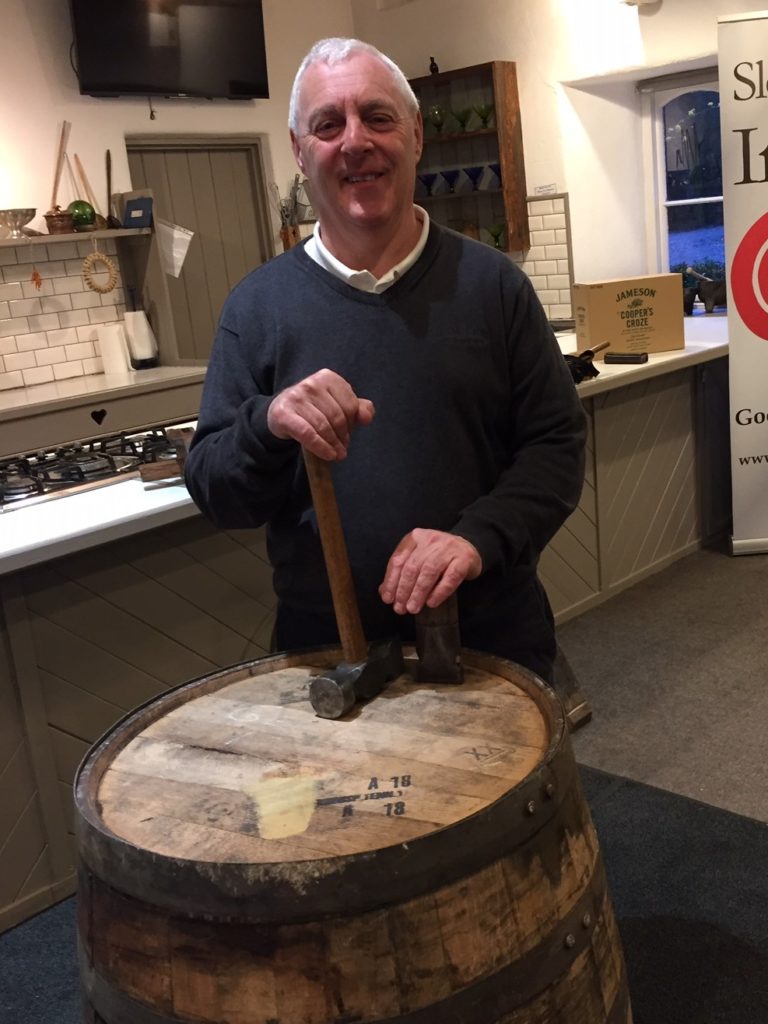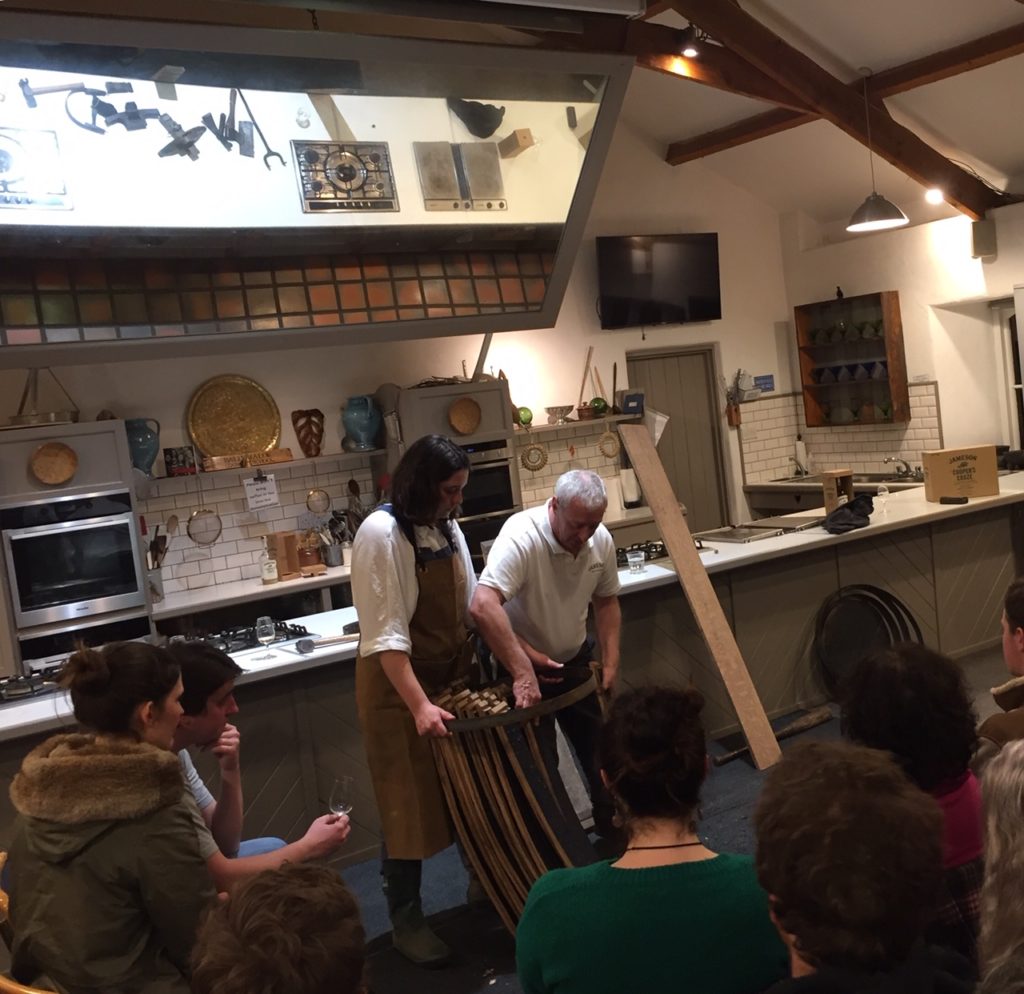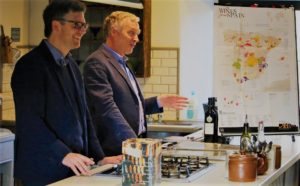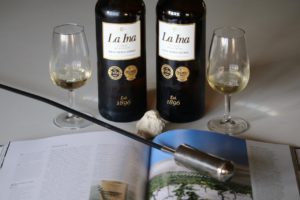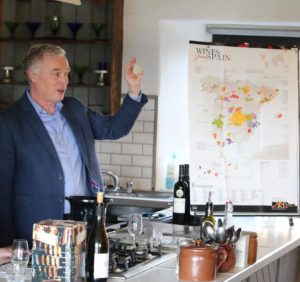Pascal Rossignol of Le Caveau, @lecaveau1, is a regular guest wine lecturer at the cookery school and last week gave a masterclass on organic, biodynamic and natural wines to the 12 week certificate students
Pascal, a passionate advocate of organic and biodynamic wines made naturally for many years, has been introducing natural wines to people here in Ireland for over the past decade. Le Caveau, ‘importer of wines sourced from quality-minded artisan vignerons whose wines are true to their origins and made as naturally as possible’ was started in 1999 and has been awarded multiple times, Best Fine Wine Merchant nationwide in Ireland.

Pascal, originally from Gevry-Chambertin in Burgundy, primarily focused on Italy (with a final stopover in a wild vineyard in Colchugua, Chile – we do like to criss-cross the world of wine during our wine classes, mirroring the global representation of the students who come from all over the world to Shanagarry in East Cork).
Natural wine is broadly speaking a wine is made from hand harvested grapes grown in a biodynamically or organically farmed vineyard, fermentation occurs with indigenous (wild) yeast, no additives, no manipulation – basically little or no intervention in the winery, with minimal or no added sulphur, all resulting in a wine with more purity, vibrancy, vitality, drinkability, and personality. We also spoke to the students about sulphur. This turned into a fascinating discussion with the students as two are science graduates. Due to allergen labelling, ‘contains sulphites’ is written on the wine label. Even if no sulphur is added at any stage by the winemaker, there will be small amounts occurring naturally in wine as a result of the fermentation process. Natural wines are generally regarded as wines that have no sulphur added by the winemaker, or the bare minimum added depending on vintage and cuvée, and even then, the amount of sulphur added would certainly be very low compared to wines at the other end of the spectrum which would be wines produced in a heavily processed way on an industrial scale. Sulphur is a preservative and an anti-oxidant, and can be found in many other things, including for example in dried fruit, as can be seen in the case of apricots where one can buy sulphured, or un-sulphured apricots.
Pascal led the class on a tutored tasting of the following wines including an ‘orange’ wine and also a wine made in ‘Qveri’.
‘Orange wines’ / amber / skin contact wines, are white wines that are made like a red, i.e. with grape skin contact.
Qvevri were the first vessels ever to be used for wine fermentation, with archaeological finds dating back to 6000 BC. Qvevri are clay vessels lined with beeswax and completely buried under the ground where the temperature stays even throughout the year, allowing the wines to ferment in the natural coolness of the earth
Our thanks once again to Pascal for another fantastic guest wine lecturer class to the 12week certificate students.
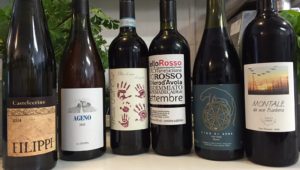
Filippi Soave, Veneto, Italy 2014
Filippi’s organic vineyards are located in Castelcerino, in the highest part of Soave, in the Veneto region of Northern Italy. Over the years, he’s incorporated some of the principles of biodynamic farming as well. 100% Garganega. As for the Soaves, while most top examples are often rich and honeyed, Filippi’s wines are some of the most structured and mineral-driven. The high elevation and volcanic and limestone soils certainly come through in the brightness and focus of the wines.
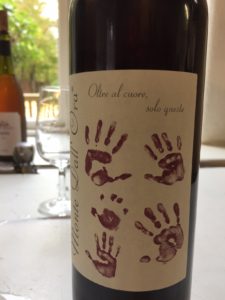
Valpolicella, Monte dall’Ora, Veneto, Italy 2015
When Alesandra and Carlo Venturini first discovered Monte dall’Ora it was love at first sight. As children of farmers, they were excited and challenged by the hard work it was going to take to restore these ancient vineyards. Located in Castelroto, in the hills outside of Verona, the vineyards of Monte dall’Ora are planted on a base of limestone soil and form a natural amphitheatre facing southeast towards the city. In fact, portions of their vineyards are planted on ancient dry stone terraces called marogna, a design in which large stones form the exterior support structure and smaller stones form a spit of land in the interior. This brittle stone, in which fossils and petrified shells can be found, allows for excellent drainage and deep penetration of the vines.
The Venturinis are firm adherents to biodynamic principles. As such, they encourage the growth of biodiversity by planting herbs such as rosemary and lavender in the summer, whose fragrant blooms are attractive to bees; and sowing cereals in the winter, whose roots move and aerate the soil. In addition, Alessandra and Carlo have emphasised traditional and native grape varieties wherever possible to give originality and typical wines. All the wines are blends of Corvina, Corvinone, Rondinella, Molinara and Oseleta. Fermentation is spontaneous with indigenous yeasts and extraction is gentle giving wines of gentle, cherry-fruited elegance.
Ciello Rosso, Nero d’Avola, Sicily, Italy 2015
Made from organic grapes Ciello Rosso Nero d’Avola has freshness and energy, dark red colour, hints of black plum, coffee and chocolate on the nose, pleasant spiciness in the mouth with smooth dark fruit flavours
The dynamic Vesco family took over the winery 10 years ago and have since revolutionised the viticultural practices and invested heavily in cutting edge technology for the winery and bottling line. Their organic vineyards are located high up in the hills above Alcamo. The wines are all certified organic and planted on south-east facing slopes on sandy soils 150 – 300m above sea level. The climate is clearly suited for producing the best quality grapes. The grapes tend to be picked earlier in the year than many of their neighbours which produces their customary bright, fresh style of wine. These wines are a million miles from the overripe styles made by many of their peers. Night harvesting and modern temperature controlled fermentations result in bright, fresh, modern wines. Inexpensive, but beautifully made and full of authenticity.
Vino di Anna ‘Qveri’, Sicily, Italy
Anna Martens & Eric Narioo, Etna Biodynamic principles, natural wine. The vineyards are at altitude (760-900metres) and are farmed organically. The Vino di Anna wines are made on their small property without much intervention, using native yeasts and no additives, save for a little SO2 in some lots (normally nothing is added at all). A variety of vessels are used for fermentation, including Palmento, old barrels and a Georgian qvevri.
“Our second Qvevri wine made in a 2,000 litre Georgian Qvevri. Nerello Mascalese was hand harvested from our “Don Alfio†vineyard located at 900 metres above Rovitello. The fruit was 100% de-stemmed by hand into the Qvevri. Alcoholic fermentation lasted just over two weeks followed by malolactic fermentation. The Qvevri was then closed and the grapes were left to macerate until April 2014. The resultant wine was pressed and put in an old oak cask until bottling in September 2014. No SO2 was added. The wine was neither fined nor filtered prior to bottling. Floral and expressive in the nose, this wine has a fine, textural structure. Morello cherries are coupled with cherry blossom. The palate is taut, complex and long.†Anna Martens & Eric Narioo
“Anna Martens and her Etna wines are one of the most exciting discoveries I have made this year. I met Anna years ago when she had just left a cellar job at Tenuta dell’Ornellaia on the Tuscan coast and had a vague memory of her moving to Etna to work with Andrea Franchetti. But I didn’t know until recently that this petite Australian had started her own wine brand on the volcano. She runs a small vineyard with her husband Eric Narioo on the north face of Etna. Many of her head-trained vines reach 100 years of age and are planted up to 900 meters above sea level. She adopts a non-interventionists – philosophy with natural yeast, no fining or filtering, and little or no SO2. Her most exciting wine, Qvevri, is made in 2,000 liter Georgian clay vessels.â€
Valli Unite Barbera, Piedmont, Italy
Valli Unite (‘United Valley’) started over thirty years ago, at a time when most young people left the land to seek work in the large cities of northern Italy. It was started by three young men from local farming families who were deeply attached to their land and traditional practices, who had a belief in organic farming and biodiversity as the way of the future and were committed to a way of life and farming that would be sustainable over the long term. Valli Unite now numbers four families and 25 people, each bringing their own strengths and talents: from vine-growing and wine-making; to cheesemaking; to animal husbandry and butchery; to a hospitality and a restaurant and shop selling their own produce. Their wines have vibrancy and sense of place.
“Barbera is plush and velvety, with a savoury, earthy, kirsch fruit character. Complex and multi-layered on the nose. Dry on the palate, with ripe black cherry and damson fruit. Well-balanced, satisfying, long finish, good grip, totally deliciousâ€
La Stoppa ‘Ageno’, Emilia-Romagna, Italy
Certified organic, natural La Stoppa is a 50-hectare property located in North-West Emilia-Romagna. Founded in the late 19th century by a wealthy lawyer named Gian-Marco Ageno, the estate is currently run by Elena Pantaleoni and head vignaiolo Giulio Armani. 32 hectares of vines are planted and the wines produced from La Stoppa are typically Emilia.
The soils consist of heavy clay, and the estate has been worked organically since the early 90’s (certified in 2008). Moving forward occasionally means taking a step back. A minimal intervention approach is taken in the cellar: the wines ferment off of their native yeasts and nothing is ever added or subtracted from the juice. Sulphur is never added during vinification, only in small doses at bottling. Because of the region’s warm climate, Giulio prefers long skin contact to extract as much as possible. Stainless steel, concrete and wooden tanks are used for fermentation and small and large oak barrels are used for aging.
Ageno is an ‘orange wine’ made from 60% Malvasia di Candia Aromatica, 40% Ortrugo and Trebbiano grown on clay/limestone soils in a very warm climate (Elena Pantaleoni, owner says that this part of Emilia can be hotter than Sicily during the summer). The juice and skins stay in contact for 30 days and fermentation takes place spontaneously with ambient yeasts. The resulting wine is matured for 12 months, half in stainless steel, the other half in used French oak barriques, with a further 2 years in bottle before release.
Deep golden/amber in colour. On first pouring, bruised apple. With air, it becomes incredibly complex: candied orange peel and grapefruit, honey, smoke, nuts, and a herbal and Mediterranean character. The palate is medium full, bone dry, again very complex and intriguing. Candied fruit flavours on the sweeter end, yet somehow also savoury, nutty, umami characteristics. Very well balanced, with linear, mouthwatering acidity, a touch of palate-cleansing astringency and a lengthy finish.
And now off to Chile, in South America…
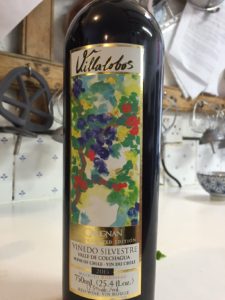
‘The Wild Vineyard’, Villalobos, Carignan Reserva, Colchagua, Chile
The Villalobos family estate is located close to the village of Ranguili and is entitled to Colchagua Valley appellation of origin. The vineyard is essentially Carignan as far as anyone can ascertain, and was originally planted during the 1940’s and 50’s. Villalobos vines have never been treated; indeed, the vines have always grown wild and free from any chemical processes for sixty years amongst native Chilean flora such as maitenes, rose-hip, Culenes, pine trees, blackberry bushes etc. In fact, the mission is the constant quest to produce a wine characterised by its unique qualities and the special Carignan variety, which had almost disappeared from Chile and is rarely found in this particular region.
The wine cellar was founded in the sculpture workshop of Enrique Villalobos, in the Artists Valley located in the Colchagua Valley. “The art of sculpture and the art of wine-making are intrinsically linked in the creation process; that is, the modification and intervention of substances offered to us by nature, which the artist may turn into a unique and particular work of art.†Given this context the winegrowers wish to distance themselves from the traditional industrial monoculture. Their main goal is to produce wines which reflect the seasonal conditions and qualities of the terroir, taking advantage of the organic and wild characteristic of the aged vines. This unique terroir allows them to harvest grapes which give the wine an aroma that is perfectly harmonised with the Chilean countryside.
The philosophy of Villalobos is based on absolute respect for the environment where the grapes are grown.
Viticultural methods involve the use of draught horses and natural forms of herb control in order to keep the natural balance. Grapes are hand-harvested, since the vines grow amongst rose-hip, blackberry bushes and other native plants, which makes the harvest a logistical challenge to say the least!
Villalobos’ Carignan is neither filtered nor fined and nothing is added to the wine which is allowed to age slowly and naturally in French oak barrels. It is the colour of a dark rosé, there is no extraction or concentration, just clean, pretty lifted, almost graphite fruit supported by clean acids.
A note on natural wine…
In its simplest form, natural wine takes organic or biodynamic practices in the vineyard as its starting point and extends them into the winery in an attempt to reduce the total use of chemical inputs and manipulations throughout the entire production process. One of key differences is often the low or zero use of sulphur dioxide (SO2).
Natural wine is not an accredited or legally defined term but refers to a broad range of desirable practices both in the vineyard and the winery. These include
-the use of organic or biodynamic treatments to bring life to the soil,
-hand harvesting,
-no capitalisation (added sugar to raise potential alcohol)
-no added enzymes,
-the use of natural wild yeasts for fermentation,
-no added “flavourings†(tannin powder, oak chips, etc)
-no adjustments e.g. either adding acidity (acidification) or taking out acidity from the wine (de-acidification),
-low or zero use of sulphur dioxide at any stage of harvesting, fermenting, or bottling
-no or very light filtration and fining
There is also a recognisably “natural wine style†emerging, which for many is the chief allure of this category. At their best, natural wines display lightness and purity of fruit. They have higher levels of acidity, often combined with more restrained levels of alcohol. They often have little or no new oak influence. They can also be nutritious in the true sense of the word, being living products, they appeal to the stomach as well as the palate. This style of course may not be everybody’s cup of tea. The proof of the pudding will always be in the drinking and as the saying goes ‘the best bottle on the table is always the empty one’.
A word about labelling…
All wines contain some sulphites, so please be wary of wine labeled ‘sans sulphites’ or ‘sulphur free’, as this may have got lost in the translation of the label when what was meant was ‘no added sulphur’. (Different labelling rules do apply eg wines sold in the USA). Wines made or sold in the EU are labelled ‘contain sulphites’ In a recent article by Jancis Robinson MW she writes: ’Sulphite is a term that covers all form of sulphur, which is a natural by-product of fermentation so all wines contain a small amount of sulphites even if none added’
The word ‘naturalement’ or ‘naturally’ or any other similar words on the front or back label does not mean it’s a natural wine as natural wine is not a regulated term, so one does not usually expect to see it written on the front or back label of a natural wine.
Bio on a label in most European labels, means Organic (and not Biodynamic)






